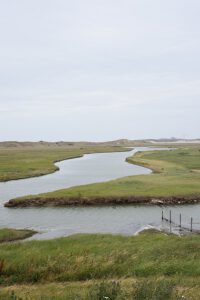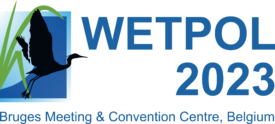Fieldtrips
On Wednesday 13 September, several fieldtrips will be organized for the conference participants. You will have a choice between a range of natural and constructed wetlands. The tours are still subject to change and might be changed in the future. The amount of registrations per tour will be limited, according to the sizes of the busses.
Tour 1
Total Value Wall – Kamp C, Westerlo
Kamp C is an autonomous company of the Province of Antwerp in Belgium. The mission is to accelerate the transition of a more durable and circular urban environment in Belgium and beyond, by giving independent advice to all stakeholders.
In 2022, Kamp C opened the first ‘fully circular office building’ in Belgium. The building sets an example for the future of the building sector. One aspect of the circular building is the incorporation of a total value wall. This is a green wall where grey water gets treated and is reused as an alternative water source.
A time-lapse was made during the construction of the building (Dutch)
More info (Dutch): Total value wall, Circular office building
Horticulture drainage water treatment – Rietland, Lochristi
Drain water of horticulture typically contains high concentrations of nitrogen and phosphorus, but low COD concentrations. Rietland designed a nature based solution for meeting the local discharge limits. The system is a hybrid between aerated and free surface flow constructed wetlands.
Occasional carbon dosing for optimal denitrification is controlled by a water temperature sensor.
More info: System overview, Article Aquarama (Dutch)
Municipal wastewater treatment – Aquafin, De Pinte
The municipal wastewater treatment plant at De Pinte – Zevergem is a classical secondary hybrid constructed wetland consisting of a vertical subsurface flow unit followed by a horizontal subsurface flow unit. The system was designed for 750 PE and has been in operation since 2000.
More info: Long-term results
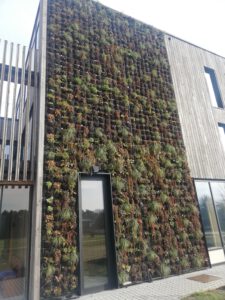
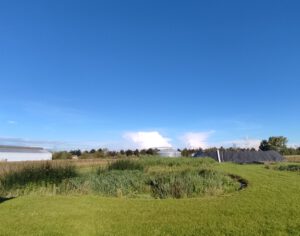
Tour 2
De Blankaart – Diksmuide
‘De Blankaart’ is an almost 1000 hectare nature reserve in the Province of West-Flanders. The reserve is situated around ‘De Blankaart’ pond which is an artifact of peat extraction during the Middle Ages.
Nowadays, the domain is an important staging area for migratory birds. The reserve is part of the Ramsar ‘De Ijzerbroeken te Diksmuide en Lo-Reninge’ and Natura 2000 ‘Ijzervallei’.
More info: Ramsar, Natura 2000
Aquaduin - Koksijde
The intermunicipal water company of ‘Veurne-Ambacht’ (IWVA) is located on the eastern part of the Belgian coast. Drinking water is locally produced from ground water, resulting in a lowered ground water table and some small scale desertification.
To counter these negative effects, effluent of the municipal wastewater treatment plant is being infiltrated in the sand dunes. The infiltration area and surroundings are part of a nature reserve called ‘De Doornpanne’, which is part of the bigger Natura 2000 ‘Duingebieden inclusief IJzermonding en Zwin’
More info: Natura 2000
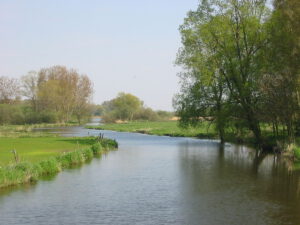
Tour 3
Het Zwin – Knokke-Heist
Het Zwin was a tidal channel of the North Sea created by the storm surge of 1134. The newly formed channel reached up to 15 km inland where it connected the city of Brugge to the North Sea. It was now possible for small ships to reach Brugge by the sea, leading to the economic flourishing of the city. By the late 13th century, the channel was silted up and the port of Brugge was no longer reachable by sea.
Nowadays the area is a natural brackish water wetland and is RAMSAR (link) and Natura 2000 (link) classified.
More info: Het Zwin website, Ramsar, Natura 2000
Aerated constructed wetlands – DOW Chemicals and Evides, Terneuzen (Netherlands)
The industrial site of DOW Chemicals at Terneuzen (Netherlands) is a 440 hectare industrial complex for the production of hydrocarbons and polymers.
Demineralized water is needed in large quantities and it is produced on-site by Evides. The main sources are local fresh surface waters, such as the ‘Maas Rivier’ and the ‘Brielse Meer’. The extensive use of water from these areas puts pressure on the local environment. Therefore Evides and DOW Chemicals are investigating whether effluent from municipal wastewater treatment plants can be used.
The chemical composition of this effluent water is of course different than water from a fresh water body. A pilot project is underway to assess the feasibility of using aerated constructed wetlands as pretreatment for the demineralization plant.
Publications from the pilot project: Khan et. al. (2022a), Khan et. al. (2022b)
